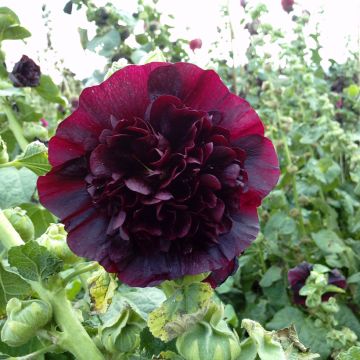

Alcea rosea Halo Pink - Hollyhock
Alcea rosea Halo Pink - Hollyhock
Alcea rosea Halo Pink
Hollyhock
Special offer!
Receive a €20 voucher for any order over €90 (excluding delivery costs, credit notes, and plastic-free options)!
1- Add your favorite plants to your cart.
2- Once you have reached €90, confirm your order (you can even choose the delivery date!).
3- As soon as your order is shipped, you will receive an email containing your voucher code, valid for 3 months (90 days).
Your voucher is unique and can only be used once, for any order with a minimum value of €20, excluding delivery costs.
Can be combined with other current offers, non-divisible and non-refundable.
Why not try an alternative variety in stock?
View all →This plant carries a 6 months recovery warranty
More information
We guarantee the quality of our plants for a full growing cycle, and will replace at our expense any plant that fails to recover under normal climatic and planting conditions.
Would this plant suit my garden?
Set up your Plantfit profile →
Description
The Alcea rosea Halo Pink is the latest addition to the 'Halo' hollyhock series, which is a beautiful collection of perennials that are more long-lived than the classic varieties and that are charcaterized by their large, single flowers with their contrasting central halos. In the second half of the summer, it displays corollas that are tightly packed along tall stems and that are very broad, white tinged with pale pink with a broad purplish-pink halo encircling a chartreuse yellow centre. This cultivar also has attractive, deeply lobed leaves, reminiscent of those of fig trees, that are more resistant to rust. Give it sunshine, well-drained soil that is not too dry and the shelter of a wall or of a low-lying bower of shrubs to protect its columns of flowers from strong winds.
Resulting from years of breeding and selection, the hollyhock 'Halo Pink' is derived fro Althaeae rosea and its many common names have adopted all the different accents of our French regions.
Of the family Malvaceae, 'Halo Pink' not only shares genes with this species native to Asia Minor but also with the fig-leaved hollyhock (Alcea ficifolia), native to Siberia, from which it takes its foliage which really resembles that of the fig-tree. The variety 'Halo Pink' is part of an improved series developed by the seed company Thompson & Morgan. It is an unbranched, upright plant that can reach 1.5 m to 1.8 m in height. It forms a branched rosette of stems covered with rough, distinctly and deeply lobed leaves, from which up to 5 robust, fast-growing flower stems emerge. These spike-shaped inflorescences are covered with many large buds that bloom, from bottom to top, into large, 10 to 12 cm wide, simple flowers that only live one day. Throughout this period, they will attract bees and butterflies to your garden. The flowers then give way to a large number of fruit, filled with seeds that spontaneously reseed in the most unexpected areas, which the plant seems to choose by itself: at the foot of walls, in poor and stony soil, in wall crevices, etc... Plants obtained in this manner, are generally very sturdy and can surprise curious gardeners.
Widespread in abandoned gardens or in wastelands in our countryside, the hollyhock is often grown at the back of beds or placed against a wall to protect it from strong winds. The fresh colour of this selection will allow you to make superb associations with the airy blooms of perennials such as gauras, sages, bellflowers, beebalms, mulleins or Royal lily for its fragrance, all of which are easy to grow in most of our gardens. Hollyhock is an edible plant: the flower buds can be eaten raw in salads and the young leaves can be eaten raw or cooked.
Hollyhock is both an ornamental and medicinal plant. Its seeds are used to produce a siccative oil. Rich in mucilages, it is a great demulcent, emollient, laxative, aperitif and it also relieves dry coughs. Its properties are nevertheless attenuated compared to those of its cousin the common marshmallow (Althea officinalis).
Flowering
Foliage
Plant habit
Botanical data
Alcea
rosea
Halo Pink
Malvaceae
Hollyhock
Cultivar or hybrid
Other Hollyhock seeds
View all →Planting and care
Sow hollyhocks from May to July. It takes 15 to 20 days for the young shoots to appear. Transplant the young plants when they have reached a height of 7 cm, 20 cm apart. In the following spring, place them in your beds, spacing them 40 to 50 cm apart. Staking is required if the area is not sheltered from winds. Avoid planting hollyhocks several years in a row in the same spot to prevent rust from appearing (a parasitic fungus in the form of orange powder) on the foliage. Even though hybrid hollyhocks tolerate summer drought and poor soils, they are much more beautiful in rich soil that stays a little moist in summer. Chalky soils are very well tolerated. When placed in heavy soil that is wet in winter, these plants will be more biennial than perennial. In optimal growing conditions, they can live 4 or 5 years.
Sowing period
Intended location
Planting & care advice
This item has not been reviewed yet - be the first to leave a review about it.
Similar products
Haven't found what you were looking for?
Hardiness is the lowest winter temperature a plant can endure without suffering serious damage or even dying. However, hardiness is affected by location (a sheltered area, such as a patio), protection (winter cover) and soil type (hardiness is improved by well-drained soil).

Photo Sharing Terms & Conditions
In order to encourage gardeners to interact and share their experiences, Promesse de fleurs offers various media enabling content to be uploaded onto its Site - in particular via the ‘Photo sharing’ module.
The User agrees to refrain from:
- Posting any content that is illegal, prejudicial, insulting, racist, inciteful to hatred, revisionist, contrary to public decency, that infringes on privacy or on the privacy rights of third parties, in particular the publicity rights of persons and goods, intellectual property rights, or the right to privacy.
- Submitting content on behalf of a third party;
- Impersonate the identity of a third party and/or publish any personal information about a third party;
In general, the User undertakes to refrain from any unethical behaviour.
All Content (in particular text, comments, files, images, photos, videos, creative works, etc.), which may be subject to property or intellectual property rights, image or other private rights, shall remain the property of the User, subject to the limited rights granted by the terms of the licence granted by Promesse de fleurs as stated below. Users are at liberty to publish or not to publish such Content on the Site, notably via the ‘Photo Sharing’ facility, and accept that this Content shall be made public and freely accessible, notably on the Internet.
Users further acknowledge, undertake to have ,and guarantee that they hold all necessary rights and permissions to publish such material on the Site, in particular with regard to the legislation in force pertaining to any privacy, property, intellectual property, image, or contractual rights, or rights of any other nature. By publishing such Content on the Site, Users acknowledge accepting full liability as publishers of the Content within the meaning of the law, and grant Promesse de fleurs, free of charge, an inclusive, worldwide licence for the said Content for the entire duration of its publication, including all reproduction, representation, up/downloading, displaying, performing, transmission, and storage rights.
Users also grant permission for their name to be linked to the Content and accept that this link may not always be made available.
By engaging in posting material, Users consent to their Content becoming automatically accessible on the Internet, in particular on other sites and/or blogs and/or web pages of the Promesse de fleurs site, including in particular social pages and the Promesse de fleurs catalogue.
Users may secure the removal of entrusted content free of charge by issuing a simple request via our contact form.
The flowering period indicated on our website applies to countries and regions located in USDA zone 8 (France, the United Kingdom, Ireland, the Netherlands, etc.)
It will vary according to where you live:
- In zones 9 to 10 (Italy, Spain, Greece, etc.), flowering will occur about 2 to 4 weeks earlier.
- In zones 6 to 7 (Germany, Poland, Slovenia, and lower mountainous regions), flowering will be delayed by 2 to 3 weeks.
- In zone 5 (Central Europe, Scandinavia), blooming will be delayed by 3 to 5 weeks.
In temperate climates, pruning of spring-flowering shrubs (forsythia, spireas, etc.) should be done just after flowering.
Pruning of summer-flowering shrubs (Indian Lilac, Perovskia, etc.) can be done in winter or spring.
In cold regions as well as with frost-sensitive plants, avoid pruning too early when severe frosts may still occur.
The planting period indicated on our website applies to countries and regions located in USDA zone 8 (France, United Kingdom, Ireland, Netherlands).
It will vary according to where you live:
- In Mediterranean zones (Marseille, Madrid, Milan, etc.), autumn and winter are the best planting periods.
- In continental zones (Strasbourg, Munich, Vienna, etc.), delay planting by 2 to 3 weeks in spring and bring it forward by 2 to 4 weeks in autumn.
- In mountainous regions (the Alps, Pyrenees, Carpathians, etc.), it is best to plant in late spring (May-June) or late summer (August-September).
The harvesting period indicated on our website applies to countries and regions in USDA zone 8 (France, England, Ireland, the Netherlands).
In colder areas (Scandinavia, Poland, Austria...) fruit and vegetable harvests are likely to be delayed by 3-4 weeks.
In warmer areas (Italy, Spain, Greece, etc.), harvesting will probably take place earlier, depending on weather conditions.
The sowing periods indicated on our website apply to countries and regions within USDA Zone 8 (France, UK, Ireland, Netherlands).
In colder areas (Scandinavia, Poland, Austria...), delay any outdoor sowing by 3-4 weeks, or sow under glass.
In warmer climes (Italy, Spain, Greece, etc.), bring outdoor sowing forward by a few weeks.





























































